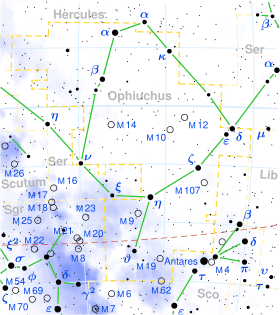Xi Ophiuchi
| Observation data Epoch J2000 Equinox J2000 | |
|---|---|
| Constellation | Ophiuchus |
| Right ascension | 17h 21m 00.37520s[1] |
| Declination | −21° 06′ 46.5663″[1] |
| Apparent magnitude (V) | 4.39[2] |
| Characteristics | |
| Spectral type | F2V[3] |
| U−B color index | -0.06[4] |
| B−V color index | +0.41[4] |
| Astrometry | |
| Radial velocity (Rv) | -9.10[5] km/s |
| Proper motion (μ) | RA: +263.84[1] mas/yr Dec.: -205.85[1] mas/yr |
| Parallax (π) | 57.62 ± 0.26[1] mas |
| Distance | 56.6 ± 0.3 ly (17.36 ± 0.08 pc) |
| Absolute magnitude (MV) | 3.19[2] |
| Details | |
| Mass | 1.37[6] M☉ |
| Radius | 1.4[6] R☉ |
| Luminosity | 4.43[2] L☉ |
| Surface gravity (log g) | 4.37[7] cgs |
| Temperature | 6,848[7] K |
| Metallicity [Fe/H] | -0.17[2] dex |
| Rotational velocity (v sin i) | 20.5[8] km/s |
| Other designations | |
| Database references | |
| SIMBAD | data |
Xi Ophiuchi (ξ Oph) is a is a multiple star system in the constellation Ophiuchus, approximately 56.6 light years away based on parallax.[1]
The primary is a class F2V[3] (yellow-white dwarf) star with apparent magnitude is 4.39.[2] Component B has a magnitude of 8.9 and a separation of 3.5", while component C has a magnitude of 13.7 and a separation of 10.8.[9]
References
- 1 2 3 4 5 6 Van Leeuwen, F. (2007). "Validation of the new Hipparcos reduction". Astronomy and Astrophysics. 474 (2): 653. arXiv:0708.1752
 . Bibcode:2007A&A...474..653V. doi:10.1051/0004-6361:20078357. Vizier catalog entry
. Bibcode:2007A&A...474..653V. doi:10.1051/0004-6361:20078357. Vizier catalog entry - 1 2 3 4 5 Anderson, E.; Francis, Ch. (2012). "XHIP: An extended hipparcos compilation". Astronomy Letters. 38 (5): 331. arXiv:1108.4971
 . Bibcode:2012AstL...38..331A. doi:10.1134/S1063773712050015. Vizier catalog entry
. Bibcode:2012AstL...38..331A. doi:10.1134/S1063773712050015. Vizier catalog entry - 1 2 Gray, R. O.; Corbally, C. J.; Garrison, R. F.; McFadden, M. T.; Bubar, E. J.; McGahee, C. E.; O'Donoghue, A. A.; Knox, E. R. (2006). "Contributions to the Nearby Stars (NStars) Project: Spectroscopy of Stars Earlier than M0 within 40 pc--The Southern Sample". The Astronomical Journal. 132: 161. arXiv:astro-ph/0603770
 . Bibcode:2006AJ....132..161G. doi:10.1086/504637.
. Bibcode:2006AJ....132..161G. doi:10.1086/504637. - 1 2 Mallama, A. (2014). "Sloan Magnitudes for the Brightest Stars". The Journal of the American Association of Variable Star Observers. 42: 443. Bibcode:2014JAVSO..42..443M.Vizier catalog entry
- ↑ Gontcharov, G. A. (2006). "Pulkovo Compilation of Radial Velocities for 35 495 Hipparcos stars in a common system". Astronomy Letters. 32 (11): 759. Bibcode:2006AstL...32..759G. doi:10.1134/S1063773706110065.
- 1 2 Allende Prieto, C.; Lambert, D. L. (1999). "Fundamental parameters of nearby stars from the comparison with evolutionary calculations: Masses, radii and effective temperatures". Astronomy and Astrophysics. 352: 555. arXiv:astro-ph/9911002
 . Bibcode:1999A&A...352..555A. Vizier catalog entry
. Bibcode:1999A&A...352..555A. Vizier catalog entry - 1 2 David, Trevor J.; Hillenbrand, Lynne A. (2015). "The Ages of Early-Type Stars: Strömgren Photometric Methods Calibrated, Validated, Tested, and Applied to Hosts and Prospective Hosts of Directly Imaged Exoplanets". The Astrophysical Journal. 804 (2): 146. arXiv:1501.03154
 . Bibcode:2015ApJ...804..146D. doi:10.1088/0004-637X/804/2/146. Vizier catalog entry
. Bibcode:2015ApJ...804..146D. doi:10.1088/0004-637X/804/2/146. Vizier catalog entry - ↑ De Medeiros, J. R.; Alves, S.; Udry, S.; Andersen, J.; Nordström, B.; Mayor, M. (2014). "A catalog of rotational and radial velocities for evolved stars". Astronomy & Astrophysics. 561: A126. arXiv:1312.3474
 . Bibcode:2014A&A...561A.126D. doi:10.1051/0004-6361/201220762. Vizier catalog entry
. Bibcode:2014A&A...561A.126D. doi:10.1051/0004-6361/201220762. Vizier catalog entry - ↑ Mason, Brian D.; Wycoff, Gary L.; Hartkopf, William I.; Douglass, Geoffrey G.; Worley, Charles E. (2001). "The 2001 US Naval Observatory Double Star CD-ROM. I. The Washington Double Star Catalog". The Astronomical Journal. 122 (6): 3466. Bibcode:2001AJ....122.3466M. doi:10.1086/323920. Vizier catalog entry
This article is issued from Wikipedia - version of the 12/2/2016. The text is available under the Creative Commons Attribution/Share Alike but additional terms may apply for the media files.
